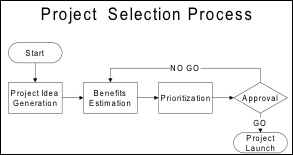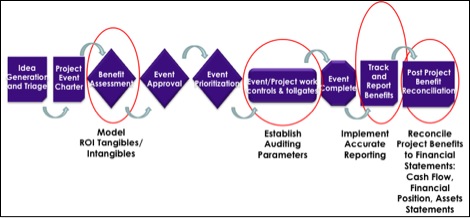By Julie Brignac, President, QuantumSix Solutions, Inc.
Business Challenge
Business Improvement initiatives are getting a lot of press these days:
“…our projects saved over $10M in the first 12 months of deployment using BPM”1.
Thus, it seems logical for an organization to jump onto the process improvement bandwagon. Much is promised of business improvement efforts, and there are many capable consultants and companies willing to support a company’s BPM deployment that can last months to years. But how does an organization know that the business improvement efforts will really result in a quantifiable benefit to the business? Process improvement initiatives are not inexpensive to start or sustain over many years, and most executives require the clear identification of benefits to justify the expenditure of training resources and driving project work before approving a long-term initiative.
Identifying project benefits and estimating an accurate return on investment (ROI) can be very challenging for most organizations. There are several possible reasons why ROI often goes unmeasured. First, some organizations are satisfied with the general improvement in their financial statements after implementing a Business Improvement methodology, such as Lean Six Sigma, and have not deemed it necessary to reconcile the benefits to the company financials because the company is holistically performing better. Secondly, some companies focus intensely on training resources and executing projects in the early stages of a process improvement initiative, and place secondary emphasis on measuring ROI, believing that the benefits will come. Lastly, some companies attempt to measure ROI, yet they are unsure how to quantify project benefits, especially if their business is focused more in a services industry. In any case, it is evident that even after 35+ years after Motorola introduced Six Sigma to the world, there is still a significant knowledge gap in how to quantify project benefits and truly link them to a company’s financial performance.
As Business Improvement efforts have matured and become more commonplace over the last few decades, many companies assume that simply learning the tools and driving the project to completion will deliver the desired benefits. The well-reported results of industry pioneers, such as General Electric, Honeywell and DuPont, as well as the pressing need to reduce costs and improve productivity, have encouraged company leaders to push their teams to undertake process improvement initiatives. Sometimes, after an initial burst of enthusiasm, these efforts languish over time, because benefits have not been accurately estimated or verified as impacting the bottom line. When it comes time to reduce costs quickly, the process improvement initiative may give way to immediate cost cutting pressures. Sadly, in many of these cases, the process improvement team has missed an opportunity to bring true credibility to the Business Improvement effort by implementing a process that directly reconciles project benefits to the company’s accounting and reporting systems.
In some cases, benefits can be reconciled as tangible contributions to the income statement; but in others, benefits may not be so evident during a reconciliation process. In any event, establishing a rigorous project benefit validation process is a critical factor in the success of the initiative, ensuring that there is no question as to the financial impact and effectiveness of the process improvement program.
Project Selection and Overall Governance
It is widely understood that a strong project governance process is key to the successful execution of projects. An overall project governance process is how projects are identified, selected, executed and reported. However, in most project governance processes, a key element is often forgotten, especially in the early stages, which typically represents how projects are selected. That key element is Benefit Estimation.
Figure 1 below represents a Project Selection Process, which is the front-end of an overall governance process, where we incorporate the critical step of Benefit Estimation:

Figure 1: Project Selection Process, incorporating a Benefits Estimation step
While most organizations recognize the value of properly vetting project ideas and opportunities prior to launching a project, many fail to follow the process for every project. Some may launch projects before a proper prioritization effort has taken place, or others may spend too much time in the idea generation phase. Often, organizations fail to estimate potential benefit prior to project chartering or prioritization of projects. Experience has shown that the pressures to get started, or to drive quick results, pushes teams to launch projects without taking the time to adequately plan or determine probable benefits. This ineffective approach to project selection and prioritization means that projects are often executed without being fully linked to the organization’s overall strategic goals, and as a result, too many projects are chartered, and few are completed to the company’s expectations.2
To understand the value of benefit estimation in initial project selection process, we should consider the value of a strong benefit validation process throughout the rest of the governance process. Figure 2 illustrates an end-to-end governance process, from project selection through execution and post-project reporting:

Figure 2: End-to-End Project Governance Process, highlighting Project Benefit Validation elements
The circled steps in the process are where a project benefit validation process adds incremental value. Not only does a project benefit validation process help with initial benefit estimation during project selection, it adds rigor during project execution by defining project benefits with more accuracy and clarity. This facilitates credible benefit reporting, and establishes a foundation for post-project benefit reconciliation, where benefits can actually be reconciled to the organization’s financial statements. Simply stated, the benefits driven by the Business Improvement effort can now be fully understood as to their impact to the business.
While the quick implementation of projects may create energy and short-term gains, the long-term impact is usually negligible, at best, without a benefit validation process. The “quick hits” and “low-hanging fruit” produce rapid, easy results for the organization, but without having implemented a true benefit validation process, it becomes more difficult to quantify more challenging or complicated project efforts.
A strong project benefit validation infrastructure can support the business improvement initiative as it matures and takes on more challenging aspects of the business. It can provide not only the basis for identifying and approving projects, but serve as a way to maintain the momentum of the initiative and retain ongoing management and stakeholder support.
An Approach to Project Benefit Validation
In order for organizations to properly address the challenges with measuring project benefit ROI, it behooves them to develop and hone a process and set of principles to address those challenges. A best practice is to design end-to-end financial tracking and reconciliation process that delivers the following results in order to better understand and quantify the benefits that their projects are delivering:
- Ability to customize project benefit financial rules, regardless of the type of project (Six Sigma, Lean, Business Improvement or otherwise) in accordance with specific company financial policies and guidelines;
- Integration with the company’s general ledger and financial reporting system;
- Utilization of value stream mapping or high level process mapping that directly links process improvements to the financial statements;
- Reconciliation of calculated savings with actual financial movements and transactions within the general ?ledger and reporting system;
- Integration and comparison with the company’s financials, as included in the project governance process, with the real financial transactions going through the accounting system;
- Output reporting for key schedules for Management Accounts relating to the improvement program;
- Ability to quantify and measure benefits that are often regarded as “un-measurable”, which are often critical measurements in terms of productivity gains, and can, in some cases, be quantified as tangible, reconcilable benefits; and,
- Direct control and governance of the Business Improvement program; including more accurate project benefit ROI, in a way that directly and auditably reconciles to the company’s accounting and reporting systems. ?
If a process is developed considering the above elements, then an integration of guidelines, tools and templates can be folded into an existing project governance process, as illustrated in Figure 3: ?

Figure 3: Project Governance Process, incorporating project benefit validation elements
Let’s explore how each tool drives a strong project benefit validation infrastructure.
Project Benefit Validation Guidelines
Developing rigorous Project Benefit Guidelines is key to a successful project benefit validation process. It is within this development exercise, and subsequent guideline implementation, that all the project benefit rules are defined and set. The guidelines house the benefit definitions, project categories, examples, tools and templates needed to execute a strong project benefit validation process. While a certain set of guidelines for an organization can be lengthy, understanding the foundational definitions that are core to the guidelines are crucial. Those definitions should be defined as Tangible and Intangible, replacing the typical industry standard definitions of hard and soft benefits.
These terms are mildly different in definition than terming benefits as “hard” or “soft”. Where tangible and hard benefit definitions are virtually the same in that they represent actual savings to the bottom line, intangible benefits are more than savings that are deemed as “soft”. In fact, intangible benefits can often be quantified via margin moves or significant shifts in business metrics, but are usually not reconcilable to the financial statements.
In summary, the guidelines are the backbone of the project benefit validation process, and act as an overarching umbrella through the various stages of project definition, benefit definition and benefit identification and reconciliation. A work of caution, however, on developing project benefit guidelines – the process to develop them can be time consuming, as many functions need to come together to author a comprehensive set that is specific to an organization. Specifically, the Lean Six Sigma/Business Improvement function and Finance must work in partnership to ensure that the definitions and project categories are clear and complete in order for the validation infrastructure to be built. Developing the process internally can take as long as 12 – 18 months, but an organization can consider working with consultancies that specialize in this type of effort who customize project benefit validation intellectual property and work to implement it more quickly into an organization.
Benefit Assessment
As previously mentioned, performing a benefit assessment prior to the prioritization and approval process is key to ensuring that the organization is choosing projects that are aligned with the company’s strategic objectives. An initial benefit assessment after the project chartering stage also allows proper selection of projects to be executed, supports the alignment with the overall strategic objectives of the organization, and allocates resources internally to drive the projects to completion.
An organization should develop and customize ROI Benefit Modeling Template that incorporates the key project benefit definitions and categories defined in the guidelines. When this template is built, financial representatives in the business can build benefit models consistently and effectively in support of the Business Improvement effort. And, in order to build an effective benefit assessment model, one has to consider three key pieces of information that are incorporated into the benefit templates: time, resources and volume.
The finance representatives, in partnership with the project leaders, can obtain this relevant information from a SIPOC or any process maps, as well as from the strategic objectives set forth by the business leaders. As a result, we can estimate effectively the amount of time; resources and volume exist from both the current and future states. We can then refer to our customized project benefit definitions and project categories (defined in the guidelines), and determine whether the benefits to be derived from this project will be tangible or intangible. This initial benefit assessment is powerful information, and allows the organization to make the best decisions in prioritizing and approving our project work.
Project Work/Execution
Periodic auditing of project benefits is necessary during the course of the project work so that accurate reporting occurs during the realization phase. A required element to ensure proper review of all active projects is to establish auditing parameters for the portfolio.
Parameters can be established based on several different factors, such as estimated benefit contribution at realization or project duration. It is important, however, to establish a rigorous audit schedule that will lend credibility to your benefit reporting.
It is also important to note that periodic auditing facilitates more accurate estimation of project benefits to be delivered, since better data is gathered during the project execution stage. This, of course, enables more refined tracking and reporting of benefits, so that an accurate impact to the business, as a result of the project, can be determined. This process enables significant confidence of project benefit reporting and delivery to the organization.
Track and Report Benefits
The most significant result of implementing a project benefit validation process is to guarantee accurate reporting of project benefits. A structured process defines financial tracking and reporting to a level that fully integrates with the company’s financial infrastructure. It also drives an appreciation for benefits that impact the company’s objectives – and whether they are tangible or intangible in nature.
It is important to note that while the initial benefits in some scenarios are deemed intangible, a validation process can assist in the determination of related benefits for an intangible-focused project that may indeed affect the financials with tangible benefits. For example, those projects focused on productivity related efforts involving headcount can initially be identified as intangible if the organization does not plan to remove the associated costs of the headcount. In this case, the benefits are certainly intangible, yet can be quantified because we understand that we are doing more work with the same amount of people. However, if a decision is made to remove that headcount from the organization, those costs are now removed, and become tangible since the process can track the removal of those costs directly to the profit and loss statement. In summary, a strong infrastructure facilitates important discussions and allows the organization to make better decisions based on better data – driven by improved financial rigor.
Post Project Benefit Reconciliation for Tangible or Intangible Results
One of the most significant features of a good project benefit validation process is the ability to reconcile tangible project benefits to the company’s financial statements, or determine that projects are driving benefits that are not reconcilable. In the case of reconciling tangible benefits, we design a specific template that mirrors the organization’s profit and loss statement, while feeding the tangible project benefits into the reconciliation process. As a result, the company can clearly identify benefits derived from the projects, and has access to an estimation tool that determines future fiscal year goals and deliverables.
Summary
The implementation of a project benefit validation process drives significant improvement in ROI accuracy, project reporting and financial internal controls for Business Improvement projects. The process can be implemented during any maturity stage of a Business Improvement deployment, and is effective regardless of whether or not the company uses a project management portfolio database. When the model is paired with a portfolio database solution, a deployment has all the necessary elements to drive world-class project governance and the successful completion of Business Improvement projects.
Purchasing & Supply Chain Expert for ManagingAmericans.com, President, QuantumSix Solutions, Inc.
Footnotes:
1 Actual performance from a Lean Six Sigma effort for a document management company located in Atlanta, GA
2 QuantumSix Case Study of selected Fortune 100 companies, published October 2009